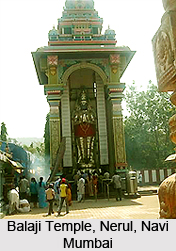 Balaji Temple, Nerul, Navi Mumbai is built on the lines of Venkateshwara Temple at Tirupati and has been constructed according to the Shilpashastras. The main deity is Balaji, in addition Ganapathy, Anjaneyar in sitting (yoga) position, Narasimhar and Padbavathy Thayar. There is a sannathy for Ramanujar also. It is known that Ganapathy Sannathy in a Balaji temple is unusual as per practice in the South, the reason maybe due to the stature of Ganapati in Maharashtra.
Balaji Temple, Nerul, Navi Mumbai is built on the lines of Venkateshwara Temple at Tirupati and has been constructed according to the Shilpashastras. The main deity is Balaji, in addition Ganapathy, Anjaneyar in sitting (yoga) position, Narasimhar and Padbavathy Thayar. There is a sannathy for Ramanujar also. It is known that Ganapathy Sannathy in a Balaji temple is unusual as per practice in the South, the reason maybe due to the stature of Ganapati in Maharashtra.
There is a Navagriha Sannathy also in an annex opposite the temple. The Balaji Temple, Nerul, Navi Mumbai also has Rajagopuram approximately 60 feet high. There are steps to reach the Balaji Temple from both sides of the hillock. `Bali Peetham` and the tall `Dhwaja Stambham` can be seen as one enters the temple. Next to Bali Peetham and the Dwaja Stambham, a flight of steps leads to the `Tiru Mamani Mandapam`. The structure of the Mani Mandapam has been built based on modern architectural practices. The cement concrete surfaces are being built with exclusively carved granite stones.
Behind the Ardha Mandapam, there is the `Garbha Griham`. At the right foot of the lord is a small silver idol, which is called `Bhoga Srinivasa` or `Kautuka Bera`. This idol imbibes the essence of the Lord and is bonded to the main `Moolavar` idol by a string. There are also other idols like Shrinivasa with Sridevi and Bhoodevi made out of `Pancha Loha` known as Utsava idols (images of festivities). There are also the idols of Shri Rama, Sita, Lakshman and Anjaneya, Shri Krishna with Rukhmini.
The Balaji Temple, Nerul, Navi Mumbai maintains a chappal stand, which aids the worshipper in keeping their footgear safely. A garden full of shade-giving trees can also be seen under well maintenance. From the rear side of the temple, there is a beautiful view of the famous Palm Beach Road that connects Vashi with Belapur and goes via Nerul. One can also have a panoramic view of the Nerul node of Navi Mumbai including the sea, which is beyond Palm Beach Road. Navi Mumbai is well connected to the proper city Mumbai through railways and roadways are not a bad option either.





















